Western
Calendar | Japanese
Calendar | Event |
|---|
August,
1871 AD | Day 12,
Month 7,
Meiji 4 | Born in Anao, Kameoka-shi, Kyoto as eldest son of rice farmer Yoshimatsu Ueda and his wife Yone. Original name: Kisaburo Ueda. Sickly but gifted with an incredible memory. Receives special education from his grandmother Uno, well-versed in Shinto and esoteric science of kototama (mystical power is believed to reside in spoken words of the Japanese). |
| 1883 | Meiji 16 | At the age of 12
Becomes a substitute teacher at Kaiko Elementary School within Anaoji Temple. |
| 1898 | Meiji 31 | At 27
• (2nd month, 9th day) Has a week's spiritual asceticism on sacred Mt. Takakuma near his home and becomes aware of his mission to save the world.
• (8th month, 23rd day) Goes up to Ayabe to meet Nao Deguchi, who is propagating the Ofudesaki writings at a local church of the Konko faith. Leaves Ayabe in two days as this supposedly divine encounter ends in failure. |
| 1899 | Meiji 32 | At 28
• (Jul. 3) Goes up to Ayabe again at Nao's invitation.
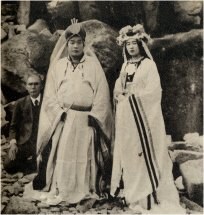 Kisaburo meeting a goddess during his spiritual training on Mt. Takakuma. |
| 1900 | Meiji 33 | At 29
• (Jan. 1) Marries Nao's youngest daughter Sumi.
• Founds the Kimmei Reigakkai organization with Nao, who has parted from the Konko religion.
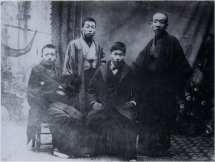 Kisaburo in a suit with believers in Osaka (1903) |
| 1908 | Meiji 41 | At 37
• (Aug.) Upgrades the Kimmei Reigakkai organization into the Dai Nippon Shusaikai, direct predecessor of Omoto.
• (Dec.) Forges ties with the Mitakekyo faith at one time but returns to Ayabe to organize his own religious group.
|
| 1916 | Taisho 5 | Age 45
• (Feb. 9) Forms the byakkotai as an arm of the Chokureigun missionary squad.
• (Apr.) Visits Mt. Unebi in Nara.
• (Jun. 25) Opens the Kamishima Islet in waters off Takasago, Hyogo. Following this ceremony, stays at a believer's house in Osaka where Nao receives the Ofudesaki message that Onisaburo is the Heavenly Miroku (Maitreya) manifested and awakens to his true identity. |
| 1921 | Taisho 10 | Age 50
• (Feb. 12) First Omoto Incident: Authorities crack down on Omoto on charges of lese majesty (injurious affront to the sovereign) and a violation of the press law. Some intellectual and military members of the Dai Nippon Shusaikai launch a rabid campaign for the great apocalypse, declaring the advent of a US-Japan war and the reconstruction of the world.
• (Jun. 17) Released on bail after spending 126 days in prison.
• (Aug.) Gives the Shinreikai magazine a new name: Kami no Kuni.
• (Aug. 5) Sentenced to a five-year prison term for lese majesty at Kyoto District Court. Immediately appeals to a higher court.
• (Oct. 18/ 9th month, 18th day) Begins dictating the Reikai Monogatari in the Shounkaku Hall at the Ayabe sanctuary. |
| 1924 | Taisho 13 | Age 53
• (Feb. 13) Though on bail, secretly leaves Ayabe for Mongolia with his entourage (including Morihei Ueshiba, founder of Aikido).
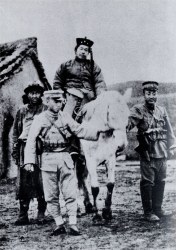 Onisaburo in Mongolia
• (Mar. 3) Leaves Fengtian for Gongyefu with his entourage.
• (Jun. 21) Entrapped by General Zhang Zuolin and forced to stand before the execution squad in Tongliao (Payintala). Eventually saved by a failure in the gun and the Japanese consulate at Shuangliao, which got wind of the situation.
• (Jul.) Put into prison in Osaka as his parole is cancelled.
• (Nov. 1) Returns to Ayabe as he is freed on bail.
• (Dec. 15) Resumes the dictation of the Reikai Monogatari. |
| 1928 | Showa 3 | Age 57
• (Feb. 1) Onisaburo's eldest daughter Naohi marries Motowo Takami (Hidemaru Deguchi).
• (Mar. 3) Declares the earthly descent of Miroku (Maitreya) at Grand Miroku Festival.
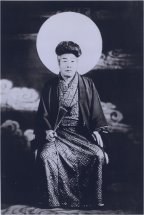 Onisaburo seated with his symbol of the full moon as a backdrop
• (May) Goes on a missionary tour of Shikoku (one of the four main islands of Japan) and writes about this mission in the Futana Diary.
• (Jul.) Goes on a missionary tour of the Tohoku and Hokkaido regions, as well as the isles of Chishima and Kunashiri. Writes about this mission in the Tohoku Diary.
Meanwhile at Kameoka, the Gekkyuden and various other buildings are constructed.
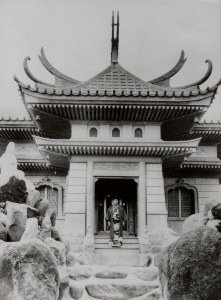 Onisaburo at Gekkyuden (Palace of the Moon) |
| 1933 | Showa 8 | Age 62
• (lunar Jan. 1) Changes the title of Omoto back to a previous one, Kodo Omoto, and dissolves the Omoto Zuishokai.
• (Feb. 6) Has the Showa Seinenkai attend an emergency meeting on the League of Nations in Kyoto.
• (Mar.) Visits Kumano Shrine in Wakayama and prays for the enhancement of national prestige.
• (Mar.) Visits the Grand Shrines of Ise and Karasu Shrine as Kodo Omoto launches the national polity drive.
• (Jun. 20) Onisaburo's mother Yone passes away.
• (Oct. 4) Starts dictating the Tensho Chizui series (Volumes 73-81) of the Reikai Monogatari. |
| 1935 | Showa 10 | Age 64
• (Feb. 7) A ceremony is held at the Zuisenkyo sanctuary in Anao (originally Onisaburo's birthplace) to enshrine the deity of Shinsei Shrine.
• (Mar. 6) Goes on a missionary tour of Taiwan. Following this tour, suspends the activities of the Showa Shinseikai.
• (Aug. 11) A holy drama based on the Reikai Monogatari is performed at Kameoka, and Onisaburo writes the script himself.
• (Aug. 22) The 16mm-film Shifukujin of the Showa Period is shot. In it, Onisaburo dresses as the Shichifukujin.
• (Oct. 8) Omoto's film-making division starts shooting for Onisaburo's biographical movie Training on the Sacred Mountain.
• (Oct. 31) The first poem festival is observed at the Tenonkyo holy grounds.
• (Nov. 17) The second poem festival is observed at a local chapter in the Hokuriku region.
Around this period, a decision is made at a Cabinet meeting to raid the Omoto headquarters.
• (Dec. 6) Leaves for Matsue, Shimane with his wife Sumi.
• (dawn of Dec. 8) Authorities suppress Omoto again (Second Omoto Incident), arresting Onisaburo and some 200 other adherents. 3,000 believers are interrogated, and 61 of them are indicted for lese majesty and a breach of the Peace Preservation Law. Onisaburo is under police escort from Matsue to Nakadachiuri Police Station in Kyoto. |
| 1940 | Showa 15 | Age 69
• (Feb. 29) Kyoto District Court finds Onisaburo and his followers all guily, and they appeal to a higher court immediately.
• (Oct. 16) First public trial is held at Osaka Court of Appeals. |
| 1941 | Showa 16 | Age 70
• (Oct. 25-26) Pleads not guilty, submitting reports to Chief Justice Takano of the Osaka Court of Appeals.
• (Dec. 8) Japanese Imperial Army makes a surprise attack on Pearl Harbor and lands on the Malay Peninsula (war with Allied powers). It is exactly six years ago, in the eighth month, since the Second Omoto Incident (Dec 8th 1935). |
| 1942 | Showa 17 | Age 71
• (Jul. 31) Osaka Court of Appeals finds all innocent of a violation of the Peace Preservation Law but gives Onisaburo a 5-year prison term for lese majesty.
Prosecution and defendants both appeal to the Supreme Court.
• (Aug. 7) Freed on bail with Sumi and Uchimaru. Remarks, "Japan will lose the war because they released me from prison!" In fact, the Battle of Guadalcanal takes place, serving as the turning point in the Pacific theater. |
| 1944 | Showa 20 | Age 74
• (Apr. 12) US air raids destroy the Supreme Court, burning 229 of the 355 volumes of documents regarding the Second Omoto Incident.
• (Aug. 15) Japan makes an unconditional surrender to Allied powers.
• (Sep. 8) The Supreme Court rejects appeals from prosecution and defendants, making the Osaka Court of Appeals' decision the final verdict.
• (Oct. 17) Remaining defendants convicted of lese majesty are all declared innocent in line with the directive of the Allied occupation forces to liberate political prisoners.
• (Nov.) Holy sanctuaries in Ayabe and Kameoka are returned to Omoto.
• (Dec. 8) Decides to start afresh with the new name of Aizen-en.
• (Dec. 8) A festival is held in Ayabe to celebrate the resolution of the Second Omoto Incident.
 A ceremony to report the settlement of the Second Omoto Incident. (Right to left, front row) Onisaburo, Sumi, Uchimaru, and believers offering prayers on Mt. Hongu at Ayabe.
• (Dec. 10) Issues a statement at Yoshioka Hot Springs in Tottori. (Yoshioka Statement [in Japanese]) |
| 1946 | Showa 21 | Age 75
• (Feb. 7) A meeting is held at the Kumano Yakata (Onisaburo's residence on Nakayada Farm) to discuss ways to run the Aizen-en. Prospectus and articles of association are drawn up, and board members are informally appointed.
• (Feb. 14) Bylaws of the Aizen-en are formally decided.
• (Apr. 1) The Aizen-en issues 10,000 copies of its magazine titled Aizen-en.
The masthead is calligraphed by Onisaburo. |
| 1948 | Showa 23 | At 76 years, 5 months and 9 days old
• (Jan. 19 at 7:55 a.m.) Ascends to heaven as head of the Aizen-en.
(Completes what he has to do in this world and returns to the Heavenly Kingdom to continue with the Divine Work as the Spirit of Mizu.)
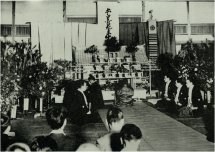 Funeral of Onisaburo as head of the Aizen-en |


